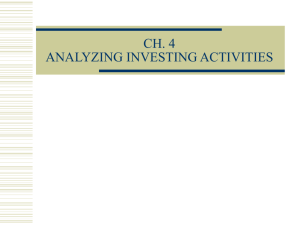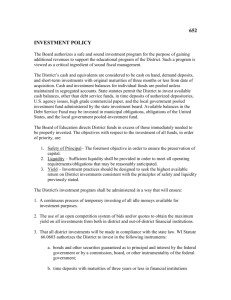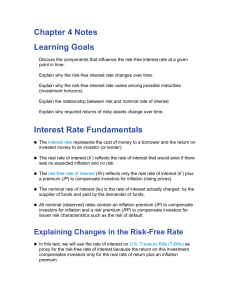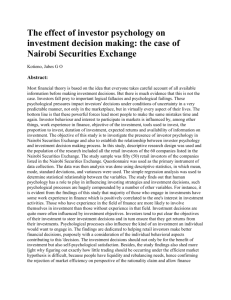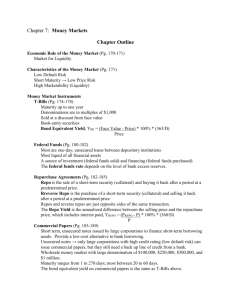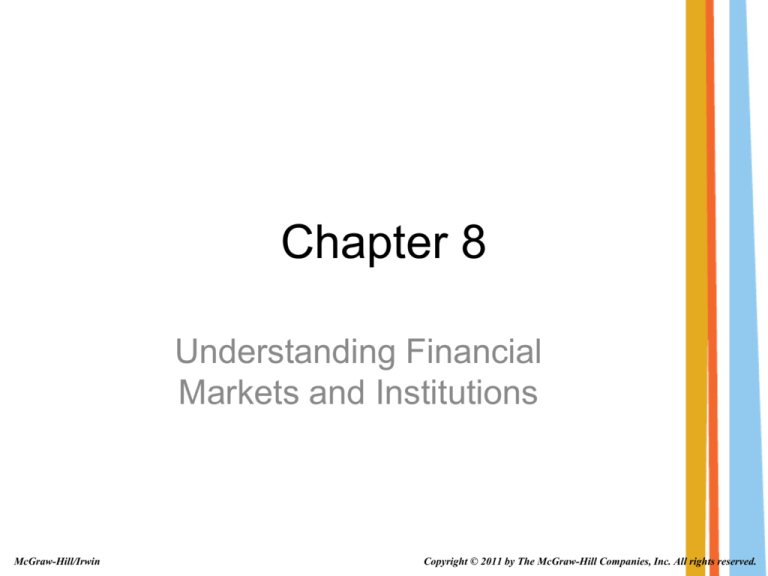
Chapter 8
Understanding Financial
Markets and Institutions
McGraw-Hill/Irwin
Copyright © 2011 by The McGraw-Hill Companies, Inc. All rights reserved.
Chapter 8 Learning Goals
LG1:
Differentiate between primary and secondary markets and between
money and capital markets
LG2:
List the types of securities traded in money and capital markets
LG3:
Identify different types of financial institutions and the services that
each financial institution provides
LG4:
Analyze specific factors that influence interest rates
LG5:
Offer different theories that explain the shape of the term structure of
interest rates
LG6:
Demonstrate how forward interest rates derive from the term
structure of interest rates
2
Financial Markets
• Financial markets exist to manage the
flow of funds from investors to
borrowers
• Financial markets can be distinguished
along two dimensions:
– Primary versus secondary markets
– Money versus capital markets
3
Primary Markets
• Provide a forum in which corporations
and governments raise funds by
issuing new financial instruments
(stocks and bonds)
• Because many companies and
government entities can’t generate
enough cash flow from internal sources
to fund their needs, they must raise
capital from external sources
(households)
4
• Financial institutions called investment
banks arrange most primary market
transactions for businesses
– Morgan Stanley
– Goldman Sachs
– Lehman Brothers
• Investment banks provide a number of
important services to businesses that
need to raise capital
– Advice
– Pricing
– Attracting investors
5
• One of the best-known types of primary
market transactions is an initial public
offering (IPO)
– Company’s shares are publicly traded for
the first time
• When a firm that is already public
issues new securities it is called a
seasoned offering
– Example: Procter & Gamble issues $500
million worth of stock
6
• Once a company’s bonds or shares of
stock are issued in the primary market
they trade among investors in the
secondary market
– NYSE
– AMEX
– NASDAQ
• Secondary markets provide a centralized
marketplace where economic agents
know they can buy or sell securities
quickly and efficiently
7
• Securities brokers such as Charles
Schwab or other brokerage firms act as
intermediaries in the secondary market
• Note: the firm that originally issued the
bond or stock is not involved in
secondary transactions
– If you buy shares of IBM through your
broker, you are buying them from another
investor. IBM has nothing to do with the
transaction
8
• Secondary markets offer benefits to
both investors and issuers
– Investors gain liquidity and diversification
benefits
– Issuers gain information about the value
of their securities
• Publicly-traded firms can observe what
investors think of their firm value and
corporate decisions by tracking their stock
price
9
• Trading volume in the secondary
market is huge
– On August 16, 2007, trading volume on
the NYSE broke the all-time record at 5.8
billion shares
– In contrast, in the 1980s a 250 million
share day was considered a high-volume
day
10
Money Markets versus Capital
Markets
• Money markets feature debt securities
with maturities of one year or less
– Because of the shorter maturity,
fluctuations in secondary market prices
are usually small
– Money market securities are less risky
than long-term instruments
– Most money market securities trade overthe-counter
11
• Corporations and governmental entities
issue a variety of money market
securities to obtain short-term funds
– Treasury bills
– Federal funds
– Repurchase agreements
– Commercial paper
– Negotiable CDs
– Banker’s acceptances
12
13
• Stocks and long-term debt (with a
maturity of greater than one year) trade
in capital markets
• Capital market instruments are subject
to wider price fluctuations than money
market instruments
14
• Capital market securities include:
– U.S. Treasury notes and bonds
– State and local government
– U.S. government agency bonds
– Mortgages and mortgage-backed
securities
– Corporate bonds
– Corporate stocks
15
16
• Other Markets
– Foreign Exchange Markets
• Events in other countries affect U.S. firms’
performance
• For example, in 2001 Argentina experienced
an economic crisis that hurt U.S. stock prices.
Coca Cola Co. attributed a 5 percent decline
in operating profits to the unfavorable
exchange rate movements between the dollar
and Argentinian peso
• Foreign exchange markets trade currency for
immediate delivery (spot) or for some future
delivery
17
• Firms that sell goods outside the U.S.
receive cash flows that are subject to
foreign exchange risk
– Investors who deal in foreigndenominated securities face the same risk
– If the foreign currency depreciates in
value, the dollar value of the cash flows
will fall
• If the foreign currency appreciates in value,
the dollar value of the cash flows will rise
18
• Derivative Markets
– A derivative security is a financial security
linked to another, underlying security such as
a stock or currency
• Futures contract
• Option contract
• Swap contract
– Derivative securities generally involve an
agreement between two parties to exchange
a standard quantity of an asset or cash flow
at a predetermined price and at a specified
date in the future
19
– As the value of the underlying security
changes, the value of the derivative
security changes
– Derivative contracts involve a high degree
of leverage
• The investor has to put up only a small
amount of the value of the underlying
commodity to control a large amount of the
underlying commodity
– Derivative markets are the newest and
potentially the riskiest financial security
market
– Derivative are used both for hedging and
speculating
20
Financial Institutions
• Financial institutions include:
– Banks
– Thrifts
– Insurance companies
– Mutual funds
• These institutions act to channel funds
from those with surplus funds to those
with a shortage of funds
21
22
• Without financial institutions, the flow of
funds between suppliers of funds
(households) and users of funds
(corporations) would be low for several
reasons:
– Institutions efficiently monitor the users of
funds
– Institutions provide liquidity to suppliers of
funds
• Even though many financial claims feature a longterm financial commitment, institutions provide a
means for suppliers to withdraw their cash as
needed
– Institutions can provide a means to lower the
price risk and transactions costs compared
to trading on secondary markets
23
• Financial institutions act as financial
intermediaries between fund suppliers
and fund users.
– Fund suppliers and users use financial
institutions because of their unique ability
to reduce monitoring costs, liquidity costs,
and price risk
24
Interest Rates
• We often speak of the interest rate as if only
one rate applies to all financial situations
– In fact there are hundreds of different rates that
are appropriate for various situations within the
U.S. economy
• The rates we actually observe in financial
markets are called nominal interest rates,
sometimes called the quoted rate
• Because changes in interest rates have a
profound impact on the value of security
prices, financial managers and investors
closely monitor these rates
25
• Factors that influence interest rates for
individual securities
– Inflation
– The “real” interest rate
– Default risk
– Liquidity risk
– Special provisions regarding use of funds
– Term to maturity
26
27
• Inflation
– Inflation is the percentage increase of a
standardized basket of goods or services
over a given period of time
– Actual or Expected inflation rate
• The higher the level of actual or expected
inflation, the higher the interest rate
• Investors want to at least maintain their
purchasing power
28
• Real Interest Rates
– The rate that a security would pay if no
inflation were expected over its holding
period
– Measures society’s relative time
preference for consuming today rather
than in the future
• Fisher Effect
– Nominal interest rates must compensate
investors for:
• Inflation-related reduction in purchasing power
• Forgoing present consumption (real rate)
29
• The Fisher Effect can be written as:
i Expected (IP) RIR [Expected (IP) x RIR]
• The last term will generally be very
small for small values of Expected (IP)
and RIR, so we often use an
approximate formula for the Fisher
Effect:
i = Expected (IP) + RIR
30
• Example: The one-year Treasury bill
rates in 2007 averaged 4.93 percent
and inflation for the year was 1.80
percent. Calculate the real interest
rate for 2007 according to the Fisher
Effect.
RIR = i – Expected (IP)
= 4.93% - 1.80%
= 3.13%
31
• Default or Credit Risk
– Default risk it the risk that a security issuer may
fail to make its promised interest and principal
payments to its bondholders
– The higher the default risk, the higher the interest
rate demanded by investors to compensate them
for the risk
– U.S. Treasury securities are considered to be free
of default risk
– The difference between a quoted interest rate on
a security j and a similar Treasury security is
called a default risk premium
DRPj = ijt - iTt
32
• Liquidity Risk
– If an asset is highly liquid, the holder can convert it into
cash at its fair market value on short notice
– If a security is illiquid, investors add a liquidity risk
premium to the interest rate on the security
– A different type of liquidity risk premium may exist if
investors dislike long-term securities because their prices
react more to changes in interest rates
• In this case, a liquidity risk premium may be added to
long-term securities because of its greater exposure to
price risk
33
• Special Provisions or Covenants
– Some securities have special features
attached to them that affect their interest
rate relative to a similar security without
the provisions
– Examples include
• Taxability (e.g. municipal bonds)
• Convertibility (into stock at a preset price)
• Callability
34
• Term to Maturity
– The relationship between interest rates
and maturity is called the term structure of
interest rates, or the yield curve
• Assumes all other characteristics, such as
default risk, liquidity risk, are identical
– In general, the longer the term to maturity
the higher the required interest rate
• Maturity premium
35
Figure 8.11A
36
Figure 8.11B
37
Figure 8.11C
38
Putting it Together
• Putting together the factors that affect
interest rates in different markets, we
can use the following general equation
for the fair interest rate:
ij* = f(IP, RIR, DRPj, LRPj, SCPj, MPj)
39
Term Structure Theories
• The three major theories to explain the
shape of the yield curve are:
– The unbiased expectation theory
– The liquidity premium theory
– The market segmentation theory
40
• Unbiased Expectations Theory
– According to this theory, at any given
point in time the yield curve reflects the
market’s current expectations of future
short-term rates
– Intuition:
• If an investor has a 4-year investment horizon
they could
– A) buy a 4-year bond and earn the current (spot)
annual yield on a 4-year bond each year for four
years
– B) buy four successive 1-year bonds (of which they
know only the current one-year spot rate, but they
have expectations of the rates in years 2,3, and 4.)
41
• According to the unbiased expectation
theory, the return from holding a 4-year
bond to maturity should equal the
expected return for investing in four
successive 1-year bonds.
– If not, then an arbitrage opportunity exists
42
– According to the unbiased expectations
theory, an upwardly sloping yield curve
indicates that future one-year rates will be
higher than they are currently
– The theory states that current long-term
interest rates are geometric averages of
current and expected future short-term
interest rates
– [insert equation 8-7]
43
44
• Liquidity Premium Theory
– This theory builds on the unbiased
expectations theory
– It states that investors will hold long-term
maturities only if these securities are
offered at a premium to compensate for
future uncertainty in the security’s value
• Investors must be offered a liquidity premium
to buy longer-term securities that carry higher
capital loss risk
45
– The liquidity premium theory state that
long-term interest rates are geometric
averages of current and expected shortterm rates (just like the unbiased
expectations theory) plus liquidity risk
premiums that increase with the security’s
maturity
Equation 8-8
46
47
• Market Segmentation Theory
– This theory states that investors have specific maturity
preferences, and to encourage buyers to hold securities with
maturities other than their most preferred maturity requires a
higher interest rate (i.e. a maturity premium)
• Investors don’t consider securities with different maturities
to be perfect substitutes
– Examples: banks may prefer short-term securities to match
their short-term deposit liabilities, whereas insurance
companies may prefer long-term bonds to match their longterm liabilities
48
Forecasting Interest Rates
• Changes in interest rate affect the value
of financial securities, so investors and
firms have an incentive to try to predict
interest rates
• Using the unbiased expectations
hypothesis, we can discern the market’s
forecast for expected short-term rates,
called forward rates
– A forward rate is an implied rate on a shortterm security
49
– To find an implied forward rate on a oneyear security in the future we can re-write
the unbiased expectations formula
Equation 8-11
50
51


